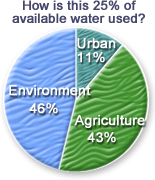About 200 million acre-feet of water falls on California each year as snow or rain. That’s enough water to cover 200 million football fields a foot deep in water. That’s a lot of water!
But most of that water-about 65%-is used by plants or evaporates from the ground or from lakes and rivers. The rest-about 35%-becomes “runoff.” Some of the runoff flows into the ocean. The remaining water is available for us to use. Of all the water that falls in California, we currently use only about 25%-in our homes and businesses, on our farms, and for our environment. Here is where the water goes:

Urban Water Use
About 11 % of California’s available water is used in urban areas-cities and towns where people live and work.
Agricultural Water Use
California farmers grow more than 250 kinds of crops, including lettuce, tomatoes, grapes, strawberries, melons, rice, hay, and cotton. Many crops-such as almonds, artichokes, kiwifruit, nectarines, olives, raisins, and walnuts-are not grown in any other states. California grows about half of the fruits and vegetables eaten in America.
Growing all this food takes quite a lot of water. About 43% of California’s available water is used in agriculture. Besides growing food for people, water is also used to grow crops, such as alfalfa and corn, that feed livestock, which is also used for food-meat, eggs, and milk products. Water is also needed for the animals to drink. A dairy cow can drink 35 gallons of water a day!
Water is important not only for the crops and livestock, but also for the soil. As irrigation water flows through the ground, it cleans out mineral salts, which can be harmful to crops growing in the soil.
Environmental Water Use
It’s not just people that need water in California. The natural environment also needs water for:
Near the coast, fresh water is also sometimes needed to keep salt water out of fresh water basins. If the fresh water-a lake or river becomes “contaminated” with salt water, the ecosystem could be damaged. And fresh water from that source may no longer be available. In other areas, water also seeps into the ground, keeping enough water in our groundwater basins.
In California, most of the rain falls in the north, creating many rivers, streams, and lakes. Therefore, the environmental needs for water are highest in northern California.

| Cookie | Duration | Description |
|---|---|---|
| cookielawinfo-checkbox-analytics | 11 months | This cookie is set by GDPR Cookie Consent plugin. The cookie is used to store the user consent for the cookies in the category "Analytics". |
| cookielawinfo-checkbox-functional | 11 months | The cookie is set by GDPR cookie consent to record the user consent for the cookies in the category "Functional". |
| cookielawinfo-checkbox-necessary | 11 months | This cookie is set by GDPR Cookie Consent plugin. The cookies is used to store the user consent for the cookies in the category "Necessary". |
| cookielawinfo-checkbox-others | 11 months | This cookie is set by GDPR Cookie Consent plugin. The cookie is used to store the user consent for the cookies in the category "Other. |
| cookielawinfo-checkbox-performance | 11 months | This cookie is set by GDPR Cookie Consent plugin. The cookie is used to store the user consent for the cookies in the category "Performance". |
| viewed_cookie_policy | 11 months | The cookie is set by the GDPR Cookie Consent plugin and is used to store whether or not user has consented to the use of cookies. It does not store any personal data. |
